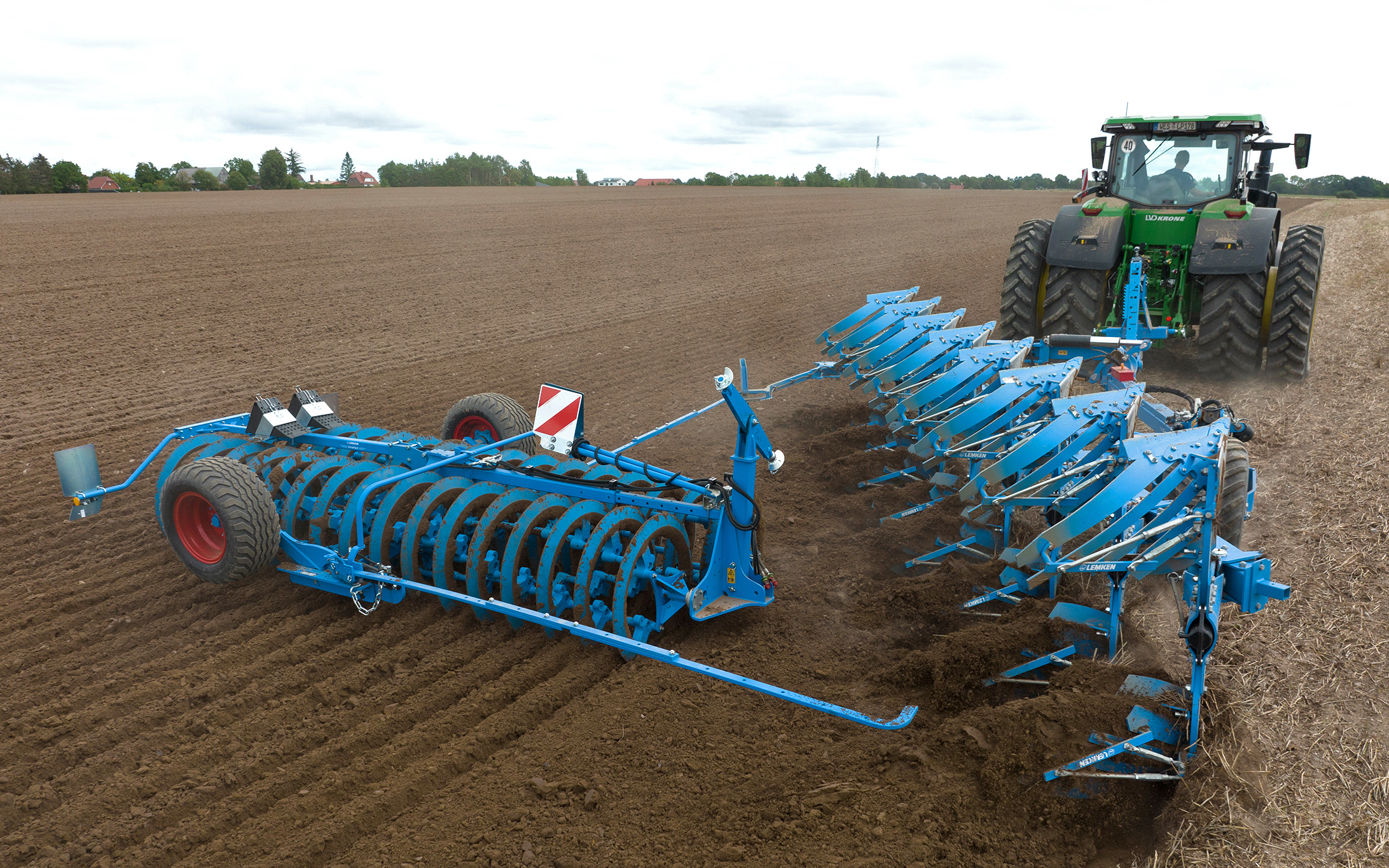Lemken and the farming consultancy, Agrii, have jointly developed trials to assess how tillage equipment interacts with soils.
Agrii agronomist, Dave Felce spoke a recent Lemken-hosted farm workshop in north Antrim.
He explained that one of the first projects involving Lemken looked at the impact of ploughing as a Blackgrass control measure.
“We actually knew that ploughing did work in this context. But we got in touch with Lemken to make sure that we were doing the job properly,” Fele said.
Soil structure
Felce went on to discuss the make-up of soils and how the different components within it interact.
“The mineral fraction of soils comprises three components – sand, silt and clay,” he said.
“Sand is the biggest aggregate. Silt and clay can be similar is size but they have different shapes. Silt is like ball bearings, while clay can be likened to bricks. So the silt can flow to fill in the gaps between the clay particles.
“Clay will be restructured, if it becomes wet or is dried out, silt won’t. In addition, clay holds nutrients, silt doesn’t. The same principles holds for sand,” he added.
He explained that when a soil’s make-up is assessed, it will determine, not only what happens when cultivated, but also its ability to hold on to nutrients.

According to Felce, many farmers underestimate the amount of silt in their soils.
“In most cases, the actual figure works out at around 50%. So this actually means that the nutrient-holding capacity of land is being significantly under estimated,” he continued.
A soil horizon can be divided up into different vertical layers, running parallel to each other, each having different physical, chemical and biological characteristics.
Felce explained that the top 2″ or so of soil must have a fine texture. This allows seeds to make strong contact with the soil, thereby generating high levels of nutrient exchange and new root development.
“Below this, we need a drilling zone, which is friable. The third layer is critically important. It must be structured so as to allow root development. However, if silt particles flow down from above to form an accumulated layer, compaction will result,” he explained.
“Moreover, if this silt and clay combination is allowed to dry out, it becomes very hard. Water permeation down the soil profile becomes impossible and root growth is every restricted.
“In these instances, sub-soiling will be required. But the only way this can be verified is by getting a spade out and digging.
“The type of subsoil that is in place, whether it be clay, limestone or chalk, determines the overall properties of the top soil that lies above it,” he said.
Grass weeds
According to Felce, mixing of the various layers within a soil profile is advisable if grass weeds represent a specific problem.
“Ploughing effectively buries this problem,” he explained. “But if there isn’t a major grass weed issue to contend with, then other forms of soil cultivation will suffice.
“But whatever approach is taken it must be implemented with precision. If we assume that 45% of our soil is made up of minerals, which is fixed, and a further 5% comprises organic matter, the remainder is made up of air and water.”
Felce went on to define what he regards as the optimal soil constituent breakdown: 25% air; 25% water; 45% mineral components and 5% organic water.
Cultivation, therefore, acts to change the balance of water and air. Getting the equilibrium within a soil across an entire field is critically important.
And it is the available organic matter that acts to makes this happen.
“Organic matter acts as a glue that binds the soil together. In doing this channels for air and water are formed,” Felce commented.
Type of soils and fertilisers
It has long been established that pH values drive nutrient availability within a soil. Where the main plant nutrients are concerned – nitrogen (N), phosphate (P) and potash (K) – there is a varying level of response, based on the levels of soil acidity or alkalinity that exist.
“The availability of fertiliser applied N and K does not drop off until soil pH values drop of to quite low levels,”Felce continued.
“Applied phosphate is almost 100% available at a soil pH value of 7.0. However, as soon as the pH value moves either side of the neutral figure, phosphate availability levels drop off very quickly.
“It is also important to place P very close to the roots of the growing plant. This is because it is very immobile in soil.”
He explained that the availability of P is reduced even further when soils are cold and wet.
“Different crops have different pH tolerances. Potatoes don’t mind acidic conditions. Sugar beet needs an alkaline pH, while the likes of oilseed rape are somewhere in the middle,” he said.

The Agrii agronomist went on to point out that soil pH values can have an even bigger impact on root growth than is the case where compaction issues exist.
E.g., as the levels of acidity increase, the availability of iron and aluminium becomes more prevalent. Both these elements are toxic, where root growth is concerned.
“Developing the correct soil structure drives crops growth, from every perspective,” stressed Felce.
“It creates the correct conditions for the placed seed to make maximum contact with the soil.
“Less than perfect soil structure, on the other hand, creates a number of problems. The first of these is poor contact between the seed and the soil. This leads to reduced levels of germination.
“We might also get problems with slugs and residual sprays. And when we apply our nutrients, we will get much less value from them,” he added.
Wet seed beds also predispose crops to attack by diseases, such as fusarium. But if farmers can develop the correct soil structure, the end result is a much better return on all the money spent in growing a crop in the first place.
Crop competition and weed control
Trial work carried out by Agrii points to a strong correlation between the competitive nature of a crop and the need for active weed control measures.
This work has confirmed a ranking order of competitiveness in autumn-drilled crops, starting at the top with hybrid barleys, followed by two-row barleys, winter wheat, beans and winter oats.

Within a spring drilling scenario, the most competitive crop is spring oats, then spring barley, spring wheat and peas.
“This is particularly the case if seed bed conditions are challenging. However, if seed bed conditions are good, then soring oats rises up the competitiveness rankings,” Felce explained.
“However, spring barley will out yield spring oats, if seed bed conditions are good.”
According to Felce, many farmers underestimate the establishment rates of their crops. The benchmark says that up to 80% is achievable. However, in many instances the actual figure comes in at around 60%, or even less.
Agrii trials have confirmed that, where winter wheat is concerned, early drilling will deliver close enough to an 80% establishment rate.
The work also confirmed that establishment rates declined as seed rates increased above a figure of 400/m². This is because of enhanced root completion within rows.
Calcium levels in soil
Felce confirmed that high levels of calcium in soil – above 6,000 parts per million – will impact negatively on the availability of potash, ammoniacal nitrogen, potash, magnesium and numerous trace minerals.
“This is because the high levels of available calcium will compete for the cation exchange sites in the soil,” he said.
“So although soils can test as being adequate for potash, in effect, the levels of the nutrient available to crops will be well below the required quantities. Or, in other words, crops will respond to the application of fresh potash.”
Felce went on to point out that soil calcium levels do not correlate with soil pH vales. The acidity within a soil is determined by the availability of free hydrogen ions in aqueous solution.
Long-term wheat trials
Long-term winter wheat trials carried out by Agrii at sites in East Anglia have confirmed a strong correlation between the number of ears produced and the quantities of potash available to the crops.
“However, ear numbers do not directly correlate with the final yields achieved, as ear size can be flexible in crops of wheat,” Felce continued.
“Nitrogen is a key driver of yield. However, it is the availability of other nutrients that maximises its impact on crop growth.”
The Agrii work has also shown that the availability of nitrogen will also impact on final crop quality and the overall margin achieved. E.g., maximising final grain protein levels is crucially important in wheat crops grown for milling purposes.
Looking at different cultivations options is also a theme that has been built into the Agrii continuous wheat trials.

Significantly, this work has shown that ploughing one year in five will improve both nitrogen use efficiency and overall gross margins by a significant amount.
This is relative to direct drilling – with or without the inclusion of cover crops within a rotation.
“Our work has highlighted the absolute importance of creating the right seed bed conditions when planting out a crop,” Felce explained.
“It is imperative for crops to have uninterrupted root growth from the get-go. Hybrid barleys tend to be more tolerant of less than perfect seed bed conditions. These crops have an inherently stronger root structure.
“The other priority is to make crops nutrients available in a properly balanced manner.”

